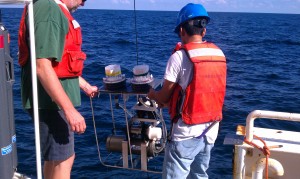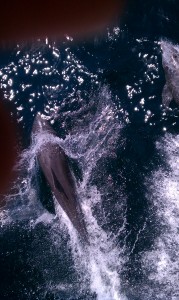And the Ship Goes Round
The day started early for many of our scientists and crew today. Even before dawn Dr. Jim McManus, Bill, Paul, and Cris were up deploying the CTD to try and determine the characteristics of the water they would be sampling. After finding sufficiently low oxygen levels Dr. Maiti deployed his In-Situ pumps. Three of them were deployed and kept at 3  different depths for over 2 hours. Once brought to the surface (at approximately 9:20), the filters were removed and the material left behind on them taken into the wet lab to be analyzed and preserved. Just after Dr. Maiti and Bill retrieved the In-Situ pumps Cris, Bill, and I ran the second CTD of the day. We dropped the CTD rosette down to 20 meters (about 1.5 m above the sea floor), and fired off 6 bottles; next we brought the CTD up to 10 meters and fired off the remaining six. Dr. Jim McManus spent the rest of the morning collecting the water from those bottles. Why did it take so long you ask? That’s because Dr. McManus wasn’t just taking the water out of the bottles. See, he’s not interested in everything that’s in the water. He only wants the water and its chemicals, not any of the life forms (plankton) that could be living in the water. So he filters the water out (which takes a little bit of time) and is left with only the part that he’s interested in studying.
different depths for over 2 hours. Once brought to the surface (at approximately 9:20), the filters were removed and the material left behind on them taken into the wet lab to be analyzed and preserved. Just after Dr. Maiti and Bill retrieved the In-Situ pumps Cris, Bill, and I ran the second CTD of the day. We dropped the CTD rosette down to 20 meters (about 1.5 m above the sea floor), and fired off 6 bottles; next we brought the CTD up to 10 meters and fired off the remaining six. Dr. Jim McManus spent the rest of the morning collecting the water from those bottles. Why did it take so long you ask? That’s because Dr. McManus wasn’t just taking the water out of the bottles. See, he’s not interested in everything that’s in the water. He only wants the water and its chemicals, not any of the life forms (plankton) that could be living in the water. So he filters the water out (which takes a little bit of time) and is left with only the part that he’s interested in studying.
After the CTD and GO-Flo samples were collected it was time for lunch, thank you Kim. After lunch the second Lander was collected; Dr. Berelson and Nick quickly got to work checking out the status of their samples and bringing them into their lab.
 Not long after the Lander retrieval a Multi-core was collected at this site. The MC (multi-core) was the last item to be deployed at this site; we spent the next couple of hours
Not long after the Lander retrieval a Multi-core was collected at this site. The MC (multi-core) was the last item to be deployed at this site; we spent the next couple of hours  steaming to our third station. We were lucky enough to encounter a pod of dolphins during our trip. They seemed to be enjoying riding the bow of the Endeavor and stayed with us for quite some time. Upon arrival we immediately deployed the CTD to make sure that the water we were in had sufficiently low oxygen levels. To everyone’s delight (except Dan J’s) the oxygen levels were quite low here. We immediately launched the multi-core and collected 6 core samples and sent them of to be poured (that’s the process of draining the water from the sediment). After retrieving the multi-core it was time for Dr. Berelson to deploy his Lander once again. He set it at the sea floor and there it sleeps tonight waiting for us to bring it back home tomorrow late morning.
steaming to our third station. We were lucky enough to encounter a pod of dolphins during our trip. They seemed to be enjoying riding the bow of the Endeavor and stayed with us for quite some time. Upon arrival we immediately deployed the CTD to make sure that the water we were in had sufficiently low oxygen levels. To everyone’s delight (except Dan J’s) the oxygen levels were quite low here. We immediately launched the multi-core and collected 6 core samples and sent them of to be poured (that’s the process of draining the water from the sediment). After retrieving the multi-core it was time for Dr. Berelson to deploy his Lander once again. He set it at the sea floor and there it sleeps tonight waiting for us to bring it back home tomorrow late morning.
If you’ve been keeping track of our blogs then you may have noticed that there is a pattern that’s beginning to form at each location. We arrive at a location, deploy the CTD, get our preliminary data, deploy the MC, deploy the Lander, go to sleep, wake up, retrieve pumps, perform GO-Flo, retrieve Lander, and head out to another site. Now there are of course changes in the schedule and additional things interspersed throughout our time at a site, but this seems to be the general pattern forming. It seems like a lot to do, and it is, but the folks here are starting to get into a rhythm and becoming very efficient at each of the steps, making our total time at each location about a day and a half. Remember, the whole point of this expedition is to gather samples that the scientists can take home and turn into data and ultimately answers to their questions (or in many cases more questions to their questions). Right now we are midway through station 3 and should be heading out to station 4 sometime tomorrow. Keep reading to see what happens tomorrow!


 August 3, 2011
August 3, 2011 






Recent Comments